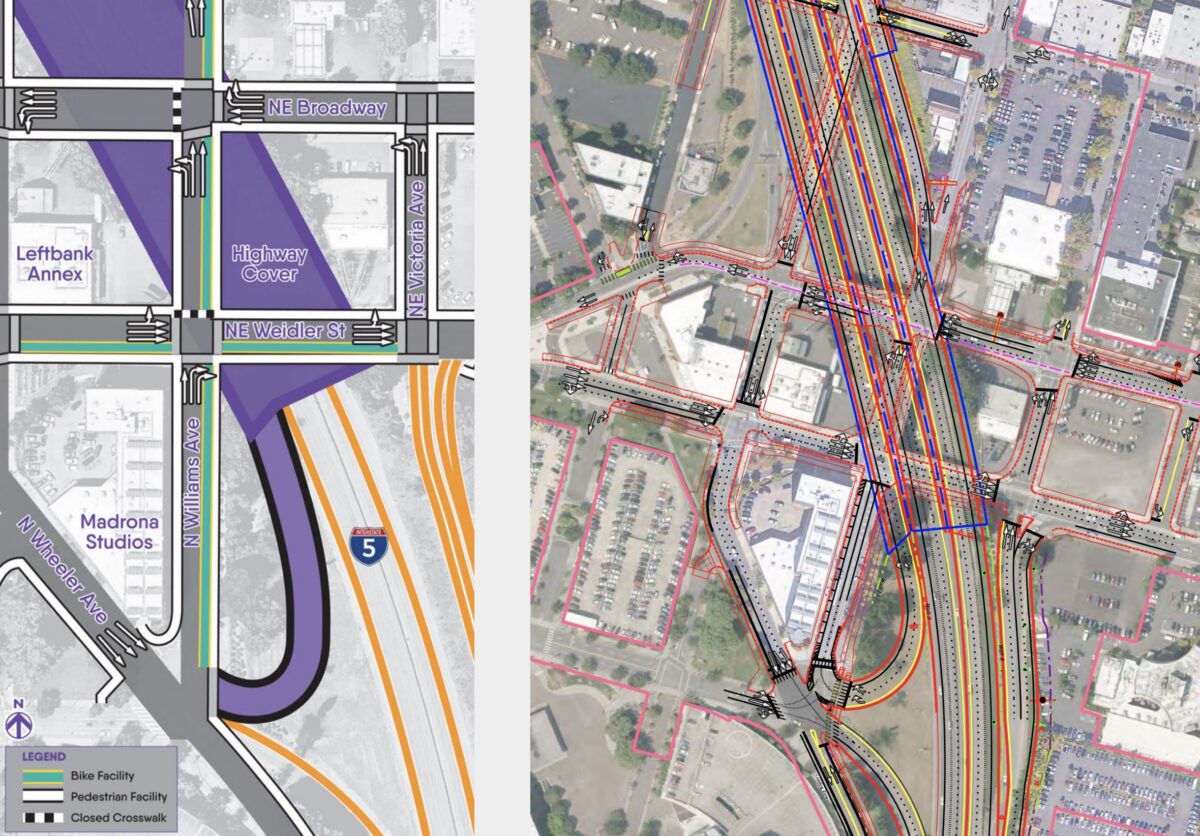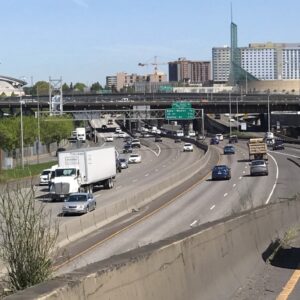“ODOT is using these sleights of hand to hide the fact that they don’t want to study an alternative that does not add additional lanes of freeway into the neighborhood.”
-Aaron Brown, No More Freeways
The Oregon Department of Transportation (ODOT) has released the long-awaited Supplemental Environmental Assessment (SEA) for its I-5 Rose Quarter expansion plan. This will kickstart a new era for the controversial freeway project, as it opens up an online open house and another public comment period and faces continued scrutiny from advocates, who are largely unimpressed with the assessment and the changes ODOT has made to the plan.
This is not the full Environmental Impact Statement (EIS) advocates want from ODOT, which would require the agency to study alternatives to the lane expansion – a task they have not embraced (to say the least). Members of the Rose Quarter expansion opposition group No More Freeways (NMF), along with the Eliot Neighborhood Association and Neighbors for Clean Air, have taken ODOT to court on the grounds that they must complete an EIS.

Last year, the Federal Highway Administration rescinded its “finding of no significant impact” (FONSI) it previously gave to the Rose Quarter project and instructed ODOT to do more environmental assessment on its impacts.
In the SEA released this week, ODOT downplays the federal verdict, saying they had agreed with the FHWA that the Rose Quarter design changes needed additional analysis. In reality, this was a setback for the project partially prompted by the NMF-led lawsuit.
ODOT’s big focus in this new Environmental Assessment is the so-called “restorative justice” element of the widening project they say will be accomplished through the highway covers that will go along with the lane expansion. We looked at the details of their latest design for the covers, which will ostensibly reconnect the Albina neighborhood that was severely impacted by the construction of I-5 more than 50 years ago.
Overall, advocates aren’t impressed.
“The [SEA] shows that the covers are, at best, a half-baked policy… [ODOT] is now making it clear it won’t do anything to pay the costs of actually building anything permanent on top of the covers,” Joe Cortright, an ODOT watchdog and co-founder of NMF, wrote in a City Observatory article about the design. “This is clear evidence of the hollowness of ODOT’s promises of restorative justice: they have no commitment to seeing anything actually gets built on these highway covers.”
But any benefits the covers could provide would be possible without a lane expansion. NMF wants ODOT to add these freeway caps to reconnect the Albina neighborhood — no lane expansion needed.
“No More Freeways is excited about and supportive of ODOT’s plans to build caps to reconnect the greater Albina community included in the proposal but believe that ODOT should move forward with the project that does not include adding additional lanes of traffic to pollute the neighborhood,” a recent NMF press release states.
In the new EA, ODOT also heralds the benefits the project will bring for active transportation in Portland’s central city, including for the construction of the Portland Green Loop, which will be routed onto NE Broadway and Weidler with sidewalk-level raised cycling lanes. In the online open house for the SEA, ODOT states that the “movement for people walking, biking and rolling would improve overall with the project compared to without the project” thanks to:
– Improved bicycle and pedestrian connections with the highway cover.
– Improved safety through signal timing to separate bicycles and pedestrians from turning vehicles.
– Improved safety through physical separation from vehicles.
But in a laudable bit of honesty, ODOT also acknowledges that conditions for bikers and walkers will get worse. They cite crosswalk closures which would create out-of-direction travel for some people, longer delays for bike riders due to new signal timing that separates them from drivers, and they even admit that there is “potential for pedestrian/auto conflict at the proposed new I-5 southbound ramp location, which could increase due to the additional traffic at this location.”
Bike advocates are very skeptical about these purported benefits (despite city and state transportation officials’ attempts to quell concerns.) In another recent City Observatory article, Cortright wrote that the new design will create an environment in which “bike riders will have to negotiate on Portland’s busy North Williams bikeway will have to negotiate two back-to-back freeway ramps that carry more than 20,000 cars per day.”
Overall, some advocates think the SEA is a continuation of a historical lack of transparency from an agency bent on promoting the freeway industrial complex at all costs. They want ODOT to analyze the impacts of congestion pricing on reducing traffic impacts on I-5 through the Rose Quarter and study air quality impacts of the expansion – both of which they say the agency has largely avoided doing as of now, even as it releases more environmental analyses.
“We believe that ODOT is deliberately using these sleights of hand to hide the fact that they don’t want to study an alternative that does not add additional lanes of freeway into the Albina neighborhood,” NMF co-leader Aaron Brown said at a press briefing on the Rose Quarter project earlier today.
The fact that ODOT has released this open house and opened the public comment period right before the winter holiday season is also suspicious to agency critics.
“It’s clear that ODOT is making it as difficult as possible for people to comment,” Brown said.
Despite their belief that ODOT has been less than transparent in their communications about this project, NMF advocates want people to participate in the public comment period. They also say they will be launching new efforts for activists to get involved in fighting the lane expansion in the coming weeks.
You can browse all the documents (including the transportation technical report), learn about bike-specific plans, and share your comment at the online open house. Comments will be accepted until January 4. Stay tuned for more coverage on the SEA and advocacy efforts around it.









Thanks for reading.
BikePortland has served this community with independent community journalism since 2005. We rely on subscriptions from readers like you to survive. Your financial support is vital in keeping this valuable resource alive and well.
Please subscribe today to strengthen and expand our work.
Thanks for the coverage!
Stay tuned – next week we’ll have a link on the NMF website to facilitate making it easier for Portlanders to submit public comment. We’ll also have information on our own events we’re hosting to show community opposition to the project.
Can someone explain to me how I-5 Southbound traffic is supposed to get to the Moda Center parking garages? I really can’t figure it out. Are they going to go north on Williams, left on Broadway, left on Vancouver…then what? Given the dominance of that movement on game days, it sounds like it will be a disaster for all the streets in this area.
After the movements you described, they would make a right off of Vancouver at the driveway shown in red. But yes, it’s a lot of movements (with pedestrian/bike crossings everywhere) to get to the parking garages…
Ugh. Making all those turns at signalized intersections is a recipe for massive conflicts between drivers and people walking and biking. And it’s a recipe for massive gridlock since signals are inefficient. Plus wide turning radii and double turns are awful in an urban environment. This is a really bad design.
It would almost make more sense to just have that new exit send traffic (the wrong way) across Williams on game days. Or dig a tunnel to the parking garages. Making everyone from Washington drive in a big loop sounds like it’ll just totally fustercluck the streets and intersections.
Notably, the part about “increased potential for pedestrian auto conflict” is buried on page 97 of the full Environmental Assessment, while ODOT’s public-facing webpage claims in the “Active Transportation” pop-up box that “movement for people walking, biking and rolling would improve overall with the project”(!) Yet more duplicity and gaslighting from ODOT.
OK, they do mention the potential for pedestrian/auto conflict lower down. Whoops!
They need to start autocorrecting “pedestrian/auto conflicts”with “crashes”, because that’s what it means. These complacent traffic engineers should at least be honest with themselves about what they’re doing: willingly putting pedestrians and cyclists at risk of serious injury so that drivers can get where they’re going. Does that sound fair and equitable?
For most drivers, needing to drive everywhere is a major inefficiency—a waste of time and money—forced upon us them by an outmoded status quo of autocentric development. We don’t see it that way, but it is NOT an actual choice people make; it’s an understandable disinterest in an inarguably difficult escape from a very burdensome present.
If a traffic engineer isn’t on board with getting people out of this infrastructural coercion—giving them real freedom of mobility—then they should leave the profession.
Comment of the week! I love it.
I don’t think I’ll live to see an environment with all hazards removed by engineering. Conflicts can be reduced but while they exist I know those are places I have to keep myself safe because the physics are against me.
MV operators lack motivation to be safe for me because ORS, enforcement, and recent jurisprudence are all playing on their team. If I’m transported from a crash the police will interview the driver and bring the ticket on to the hospital. The so-called Vulnerable Road User law only comes into play if it can be established that the driver’s hair was on fire.
Sure, engineer the heck out of the streets, and please please build long sections of limited access human power thoroughfares. But as long as we let random people who once passed a multiple choice test operate heavy machinery there will be some hilarity out there.
Driver’s Ed must be a requirement, in addition to stricter road laws, lower speed limits, and limiting all roads to 2 travel lanes max. Oh, and no more massive pickup trucks, at least without a CDL.
I just realized something…how are all the buses that go up Williams supposed to get through this mess? It doesn’t look like the northbound movement at Wheeler is even allowed.
I think you can still go northbound on Williams but it requires you to merge far left prior to Weidler and then far right prior to Broadway. And maybe the busses will be allowed to use the outer turn lanes to go straight, but it’s certainly not ideal.
Thank you for covering this BikePortland! I just submitted a comment through their web page. Maybe this can inspire others who feel the same (or disagree!)
“Hello, I am writing to express disappointment in the I-5 Rose Quarter Improvement project and Supplemental EA. While I am a fan of covering the interstate, the current proposal is clearly half-baked and focused on auto traffic. It introduces new safety concerns for pedestrians and does not come close to recognizing the potential for new development on top of the lid.
I am not a native Portlander, but I have lived here for 12 years and would love to see this become a project our city can be proud of. I would hope the design team could leverage ideas from Seattle’s Alaska Way Viaduct replacement and Boston’s Big Dig freeway project. Each of these projects successfully eliminated unsightly freeways and established new parks and plazas which are now cherished by residents.”
Using the Governor Tom McCall standard, anyone who identifies themselves as “Oregonian” is by definition a native Oregonian, whether they were born in Oregon or not; similarly with “native Portlanders.” (Tom McCall was born in California.)
McCall was actually born in Massachusetts.
unfortunately Seattle/WSDOT decided to just put a big stroad in place of the viaduct lol